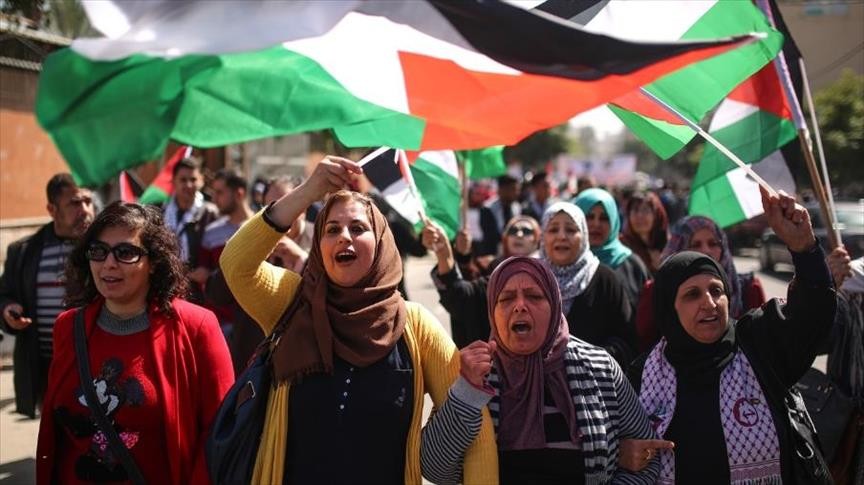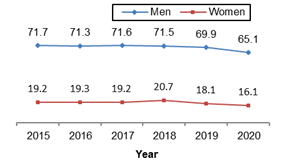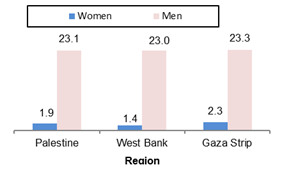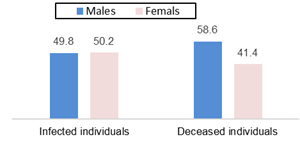H.E. Dr. Ola Awad, President of the Palestinian Central Bureau of Statistics (PCBS), on Sunday 07/03/2021, highlighted the situation of the Palestinian women on the eve of the International Women's Day, 08/03/2021
Women represent half of the Palestinian society
The estimated population in Palestine is 5.23 million for mid-2021, of which 2.66 million males (51%) and 2.57 million females (49%), whereas the sex ratio stood at 103.4; meaning that there are 103 males for every 100 females.
|
Both Sexes |
Females |
Males |
Region |
|
5,227,193 |
2,570,124 |
2,657,069 |
Palestine |
|
3,120,448 |
1,530,924 |
1,589,524 |
West Bank |
|
2106,745 |
1,039,200 |
1,067,545 |
Gaza Strip |
More than one-tenth of the Palestinian households are headed by women
The percentage of households headed by women in Palestine in 2020 was 11% (12% in the West Bank and 9% in Gaza Strip).
Significant decrease in the percentage of early marriage in Palestine
There is a decline in the percentage of early marriage (for those under the age of 18) for both sexes, where it reached 19.3% of the females’ registered marriages in 2019 (19.0% in the West Bank and 19.9% in Gaza Strip) out of total number of females registered marriages in the same year compared with 24% in 2010, while the percentage was 0.9% of males’ registered marriages of out of total number of males registered marriages in the same year, compared to 2% in 2010.
The median age at first marriage in Palestine was 20.7 years for females and 25.3 years for males in 2019.
An Increase in Life Expectancy at Birth
The life expectancy at birth for individuals has increased to 74.1 years: 73.0 for males and 75.3 for females in 2020. Yet, there is a variation in life expectancy at birth between the West Bank and Gaza Strip. It reached 74.4 years in the West Bank: 73.3 years for males and 75.6 for females. While life expectancy at birth in Gaza Strip was 73.7 years: 72.6 years for males and 74.8 for females. Reasons for such increase in life expectancy at birth includes the improvements in healthcare and the gradual decrease of mortality rates among infants and children.
Life Expectancy at Birth in the State of Palestine by Region and Sex, 2020
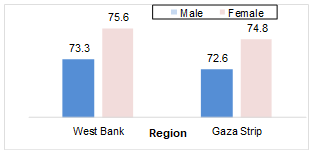
Decrease in fertility rates in Palestine
Total fertility rates decreased in Palestine from 4.1 births per woman in 2014 to 3.8 births per woman in 2019; of which 3.8 births in the West Bank and 3.9 births in Gaza Strip.
The adolescent fertility rate (age 15-19 years) in Palestine was 43 births per 1000 women in 2019, comperison with 48 births per 1000 women in 2014.
Reproductive Health among women in the age group of (15-49) years
About 95% of women aged 15-49 years received antenatal health care at least four times by a health care provider during pregnancy; and about 73% of women in the same age received health care eight times or more during pregnancy. And Most births in Palestine occur in health institutions, where about 99% of births took place. Of all live births about 100% were attended by skilled health staff.
High enrollment rates of females in secondary stage and higher education
The scholastic year 2019/2020 showed that male enrollment in secondary stage[1] was 73%, compared to female enrollment, which was 92%. As for the percentage of female students enrolled in the Palestinian higher education institutions reached 61% out of the total number of students enrolled in institutions of higher education.
Decreased in the participation rate in the labour force among women and men
The participation rate for both women’s and men’s decreased in 2020 as a result of the lockdown that were implemented following the Corona pandemic compared to previous years, as the percentage of women’s participation in the labour force was 16% of all working-age women’s in 2020, after it was 18% in 2019, Knowing that the rate of male’s participation in the labour force reached 65% in 2020, compared to 70% in 2019.
Labour force participation rate of women and men (15 years and above) in Palestine, 2015- 2020
|
|
The gap in labour force participation between women and men (15 years and above) with disabilities is deepening
According to the Labour Force Survey 2020 data, participation rate of women with disabilities in labour force in Palestine was only 2% of the total women with disabilities compared to 23% of the total men with disabilities.
Labour force participation rate of women and men with disabilities (15 years and above) by region, 2020
|
|
Youth in the age group (19–29 years) who hold Intermediate diploma and Above, suffer the most from unemployment
Unemployment rate among youth graduates of those who hold Intermediate diploma and above reached 54% (69% of females compared with 39% of males). The unemployment rate among participated women in the labour force was 40% compared to 23% among men in 2020.
Fourth of employees in the private sector get paid less than the minimum average wages (1,450 NIS) per month in Palestine.
Data in 2020 indicated that about 28% of wages employed workers in the private sector earn a monthly wage less than the minimum average wages (1,450 NIS), as the percentage was 29% for men, compared to 25% for women.
About fourth of female employees in the private sector work without an employment contract
23% of the female employees hired in the private sector work without an employment contract, and 62% of them get a contribution in financing retirement/end of service package. However, more than half of female employees in the private sector (60%) get a paid maternity leave for year 2020.
Females and males have shared infections and deaths COVID-19 (Coronavirus) in Palestine[2]
The percentage of infection cases with COVID-19 among females in Palestine up to 02/03/2021 reached 50.2% of the total infected compared to 49.8% among males, the percentage of males who died to COVID-19 is 58.6% compared to 41.4% among females out of the total number of deaths due to Covid 19 in Palestine. The total number of infected as of 02/03/2021 is 185,338, and the total deaths is 1,525 deaths.
Percentage Distribution Individual of Infected and deceased s with COVID-19 by Sex and Region,up to 02/03/2021
|
|
Israeli violations against women
3 women were martyred, 128 women were arrested in the West Bank, Jerusalem and the Gaza Strip borders in 2020, and there are 40 women still in the Israeli prisons as at the end of 2020.
A humble participation of women in decision making positions
According to 2020 data, the participation of women in decision making positions is still limited comparing to men's. These data showed that 5% of the Palestinian Central Council members, 11% of the Palestinian National Council members and 13% of the Council of Ministers members are women. Also, 11% is the percentage of the women ambassadors in the Diplomatic Service. Moreover, there is one woman holds the position governor out of 16 governors.
According to the General Personnel Council data up to February 2021, the percentage of women's participation in the civil sector reached 45% of the total employees in the public sector. The gap is reflected when talking about those who hold the rank of Director General and higher, where this percentage reached 14% of women compared with 86% of men.
[1]: From the scholastic year 2017/2018, the basic stage includes grades from one to 9th while secondary stage includes grades 10th,11th and 12th, based on the new education law issued by the Ministry of Education that consider the tenth grade in secondary stage.
2: Data excluded those parts of Jerusalem which were annexed by Israeli Occuoation in 1967

